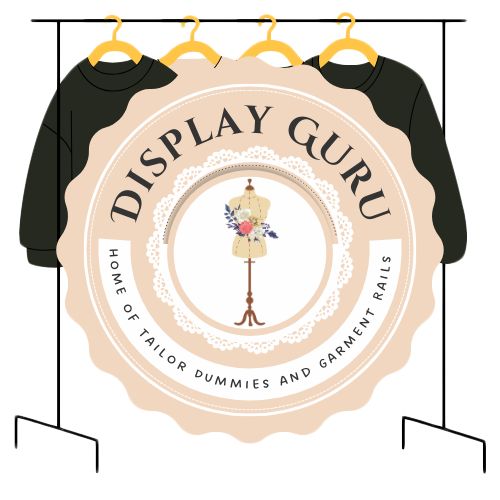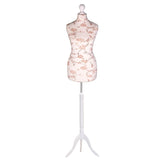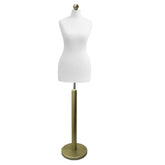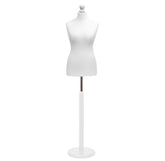Plus Size Mannequins | Stylish & Inclusive Store Displays
Why Plus-Size Mannequins Are Changing Retail
Imagine walking into a store and seeing mannequins that actually look like you and your friends. This is the refreshing change happening in retail as plus-size mannequins become more common. These aren't just bigger versions of standard mannequins; they represent a real shift in how brands connect with customers. Think of it like the difference between watching a movie with relatable characters and one with unrealistic, perfect figures.
What does "plus-size" even mean for mannequins? It generally covers UK sizes 14 to 28+, representing a much wider range of bodies than we've seen before. This has a huge impact on the shopping experience, bridging the gap between what we aspire to and what's real. When shoppers can visualize clothes on figures that resemble themselves, it builds confidence and can even encourage a purchase.
This screenshot from Wikipedia's Plus-size clothing page shows the many different clothing styles available in larger sizes, highlighting the demand for variety in this market. This range of styles underscores why it's so important for retail displays to reflect the true diversity of plus-size customers.
The Psychology of Seeing Yourself Represented
Why is this authentic representation so vital? It's about belonging and how we see ourselves. When a brand's imagery, including its mannequins, reflects us, it creates a feeling of connection and acceptance. For instance, a customer who usually struggles to find clothes that fit might be more likely to try something on if it's displayed on a plus-size mannequin. This can lead to a more positive, and hopefully long-term, relationship with the brand.
This move toward inclusivity isn't just a fad. It's a deeper acknowledgment of body positivity and the importance of representing diverse bodies in fashion. Plus-size mannequins help normalize a wider range of body types, challenging the often unrealistic ideals that have long dominated retail. This normalization creates a ripple effect, promoting self-acceptance and pushing back against outdated beauty standards. This ultimately benefits not just individual shoppers, but society as a whole. The increasing use of plus-size mannequins points toward a more inclusive and representative future for retail.
The Slow Revolution: How Retail Finally Caught Up With Reality

For decades, the standard-size mannequin reigned supreme in retail, projecting an image that felt alien to many shoppers. It was a bit like trying to squeeze a family of five into a two-seater sports car – an uncomfortable mismatch. Customers struggled to visualize how clothes would look on their own bodies, leading to a frustrating and often unsuccessful shopping experience.
But then, something began to shift. Retailers started to recognize the importance of inclusive displays, of mirroring the diverse reality of their customer base. This wasn't an overnight explosion, but a slow, steady evolution fueled by customer demand and a growing awareness within the industry. It's a story of how listening to your customers isn't just the right thing to do; it's also smart business.
This quiet revolution involved dismantling long-held industry norms and challenging the very notion of "ideal." Think back to the early days of online shopping – the skepticism, the uncertainty. The first retailers to embrace plus-size mannequins faced similar hurdles.
Yet, these pioneers paved the way for widespread change, proving that inclusivity wasn't a fleeting trend, but a vital step towards representing the real diversity of shoppers. It meant challenging the age-old assumption that only one body type could effectively sell clothes.
The arrival of plus-size mannequins in mainstream UK retail marked a significant turning point, one that took decades to achieve. While plus-size clothing had existed for years, it was often relegated to the sidelines, rarely showcased in high street displays. This started to change in 2013, when Debenhams, a major UK department store chain, announced it would introduce size 16 plus-size mannequins across all 170 of its UK stores.
The decision made headlines, lauded as a landmark moment for inclusivity in fashion retail. To put this into perspective, the average UK woman wears a dress size between 16 and 18, while most mannequins at the time displayed sizes 8 and 10. This created a significant gap between how clothes were presented and the reality of consumer bodies.
By 2013, the market for plus-size women's clothing in the UK was served by over 60 brands, though few were UK-based. Debenhams' move acted as a catalyst, encouraging other retailers to embrace size inclusivity, but it also underscored how far the industry still had to go. Learn more about plus size clothing.
The Rise of Body Positivity and Social Media
The growing body positivity movement also played a vital role in this shift. Social media amplified the voices of customers demanding better representation, putting pressure on brands to adapt. Think of it as a ripple effect, pushing more and more retailers to rethink their visual merchandising strategies. Companies like Display Guru began to specialize in these evolving needs.
This transition wasn't simply about adding larger mannequins; it was about reimagining the entire visual presentation – how clothing draped, how lighting affected perception, and how to create displays that resonated with a wider range of body types.
This evolution signifies more than just different-sized mannequins; it represents a fundamental change in how retailers perceive and value their customers. It's a testament to the power of consumer activism and the realization that inclusivity isn't just ethical; it's essential for business success. This change is ongoing, propelling the industry toward a future where all shoppers feel seen and represented in the retail environment.
Cracking The Code: Sizing And Proportions That Actually Work

The infographic above illustrates some interesting trends in the plus-size mannequin market. Over the last five years, we've seen growth in annual market rate, the percentage of plus-size mannequins sold overall, and the number of retailers using them. This increasing demand speaks volumes about the shift in the retail industry toward more inclusive representation.
Plus-size mannequins aren't just larger versions of standard mannequins. They're carefully sculpted to reflect the diverse shapes and proportions of real bodies. Imagine the difference between a simple sketch and a detailed portrait. The nuances are what make the portrait truly captivating. Similarly, the specific curves and contours of a plus-size mannequin accurately showcase how clothing will drape and fit.
Understanding Plus-Size Mannequin Sizing
While sizing can vary slightly between manufacturers, most plus-size mannequins follow a system aligned with UK dress sizes. This typically ranges from a UK size 14 to a 28 and beyond, accommodating a wide spectrum of body shapes. Understanding these size conversions and their corresponding measurements (bust, waist, and hips) is essential for making the right choice for your displays.
It's also key to remember that weight distribution isn't uniform. Someone might carry weight primarily in their hips and thighs, creating a "pear shape," while another might carry it more in their midsection, resulting in an "apple shape." Plus-size mannequins embrace these variations, offering a more realistic portrayal of different body types. This attention to detail makes all the difference in how clothing is presented.
To help you navigate these sizing considerations, we've put together a handy guide:
Plus Size Mannequin Sizing Guide Comprehensive breakdown of mannequin sizes, measurements, and corresponding UK dress sizes
| UK Size | Bust (inches) | Waist (inches) | Hips (inches) | Typical Use |
|---|---|---|---|---|
| 14 | 36-38 | 28-30 | 40-42 | Clothing designed for a curvier figure, highlighting a defined waist. |
| 16 | 38-40 | 30-32 | 42-44 | Versatile size, suitable for a wide range of plus-size clothing styles. |
| 18 | 40-42 | 32-34 | 44-46 | Popular choice for showcasing dresses and other flowing garments. |
| 20 | 42-44 | 34-36 | 46-48 | Ideal for demonstrating how clothes fit on a larger bust and hip. |
| 22 | 44-46 | 36-38 | 48-50 | Excellent for showcasing clothing designed for a fuller figure. |
| 24 | 46-48 | 38-40 | 50-52 | Suitable for displaying larger sizes, accurately representing body proportions. |
| 26 | 48-50 | 40-42 | 52-54 | Great option for showcasing plus-size formal wear and occasion dresses. |
| 28 | 50-52 | 42-44 | 54-56 | Ideal for showcasing a wider range of plus-size fashion, including casual and formal wear. |
This table provides a general overview; specific measurements might vary depending on the manufacturer. Always check the individual product details before purchasing.
Choosing the Right Proportions for Your Target Demographic
Selecting the right mannequin proportions is like choosing the right model for a photoshoot. Different proportions will resonate with different audiences. A brand targeting a younger demographic might choose mannequins reflecting trendier body shapes. A retailer specializing in classic styles might select mannequins with more timeless proportions. You can also consider checking out our adjustable mannequin guide for a more flexible approach to sizing.
By understanding these subtleties, you can create displays that genuinely connect with your customers. It's about moving beyond generic representations and presenting clothing on figures that feel real and relatable. This, in turn, helps customers visualize themselves in the garments, leading to a more positive and engaging shopping experience.
Built To Last: Materials And Construction That Matter
Thinking about investing in plus-size mannequins? It's a lot like choosing a car. A budget-friendly option will get you from A to B, but a luxury model offers a different level of performance and comfort. Similarly, the cost of a mannequin reflects the quality of its materials and how it's put together. This affects how long it looks its best and how well it showcases your clothing. Understanding these differences will help you make a smart investment.
Fibreglass Vs. High-Grade Plastics: Understanding the Options
One of the biggest factors is the material. Fibreglass mannequins are like well-crafted furniture – durable and built to withstand a lot of use. They're ideal for busy retail environments where they're constantly being handled and dressed. This robustness comes at a premium, of course.
High-grade plastics offer a more budget-friendly alternative. Think of them as the reliable everyday car. They'll do the job, but may require a bit more care. They're lightweight and easy to move, but might be prone to chipping or fading over time, especially with frequent handling. This can affect how long they last compared to fibreglass.
Mannequin Finishes: The Importance of the Right Look
The finish is another key consideration. For mannequins displayed in windows, a UV-resistant finish is like sunscreen for your mannequins! It helps protect them from fading in direct sunlight, keeping them looking fresh.
The finish also impacts how realistic the mannequin appears and how well it photographs for online marketing. A matte finish might look more natural in person, while a glossy finish can capture light beautifully under studio conditions. Just like makeup enhances features for the camera, the right finish can greatly elevate your visual presentation.
Decoding Mannequin Price Points
Understanding the interplay of materials and construction helps you appreciate the range in prices. A higher price often signifies higher-quality materials, sturdier construction, and special features like UV resistance. This translates into a longer lifespan and a consistently professional look.
Let's say you opt for a less expensive plastic mannequin. If it starts to show wear and tear after a few months, you might end up replacing it sooner than you'd like, which can add up. A fibreglass mannequin, while more expensive initially, may actually save you money in the long run thanks to its durability. Investing in quality upfront is often the most cost-effective approach. Ultimately, the best choice depends on your individual needs and budget.
To summarize the key differences, let's take a look at the following comparison:
Mannequin Material Comparison: Detailed comparison of different mannequin materials, their pros, cons, and best use cases
| Material | Durability | Cost Range | Best For | Maintenance Needs |
|---|---|---|---|---|
| Fibreglass | High | Higher | High-traffic retail environments, long-term use | Low |
| High-Grade Plastic | Moderate | Lower | Budget-conscious retailers, short-term displays, lighter use | Moderate |
This table illustrates the trade-offs between cost and durability. While fibreglass offers superior longevity, high-grade plastic provides a more accessible entry point, particularly for businesses with less demanding display needs. Choosing the right material depends on balancing your budget and the expected lifespan of your mannequins.
The Art Of Display: Visual Merchandising That Inspires

Having the right plus-size mannequins is essential. But it’s only the first step. Think of it like having a great set of paints – you still need the skill to create a masterpiece. That skill, in retail, is visual merchandising: the thoughtful styling and positioning that truly connects with customers.
This is where creativity meets consumer psychology. The most successful retailers understand that displaying plus-size clothing is about celebrating curves, not concealing them. It’s this understanding that elevates a shopping experience from ordinary to exceptional.
Creating Aspirational Yet Attainable Displays
The best displays walk a fine line: they’re aspirational, yet attainable. They invite customers to imagine themselves in the clothes, not by presenting an impossible ideal, but by reflecting realistic body shapes and styles. Think of it like the difference between a fantasy novel and a captivating biography. One whisks you away to another world, while the other inspires you within your own.
For instance, draping techniques are key. A flowing dress on a plus-size mannequin can look elegant or sloppy depending entirely on how it’s positioned. Skillful draping accentuates the garment's flow and how it complements curves, rather than hiding the mannequin's form. It's about showcasing the clothes’ potential on real bodies.
The way mannequins are grouped can also tell a story. Imagine a group of plus-size mannequins dressed for a girls' night out. Each showcases a different style, but the overall theme is cohesive. This creates a relatable scenario, prompting customers to envision themselves in those outfits for their own social events. It transforms passive looking into active engagement.
The Power of Lighting and Styling
Lighting and styling play crucial roles. Well-placed lighting can highlight the best features of both the clothing and the mannequin, creating an inviting and flattering presentation. Just as a photographer uses light to create mood and depth, retailers can use it to draw attention to specific areas of a display.
Accessorizing the mannequins adds another layer of realism and inspiration. A handbag, a piece of jewelry, or a scarf can complete the look, demonstrating how to style the pieces for different occasions. This attention to detail enhances authenticity, mirroring real-life styling choices.
Avoiding Common Pitfalls
Even with the best intentions, some retailers fall into common traps. One mistake is placing plus-size mannequins in less prominent areas, almost as an afterthought. Another is using ill-fitting clothes or styling them in ways that mask the mannequin's shape, rather than celebrating it. For more on successful displays, see our guide: Check out our guide on mannequin stands.
These missteps send a negative message, making plus-size customers feel undervalued. The goal is to integrate plus-size mannequins seamlessly throughout the store, creating a welcoming and inclusive experience for everyone. Ultimately, effective visual merchandising for plus-size mannequins is about creating displays that inspire confidence and boost sales. It’s about making every customer feel seen, valued, and inspired.
Smart Buying: Your Investment Guide To Plus Size Mannequins

Investing in plus-size mannequins is a big decision. It's a bit like choosing the right retail space – you need to balance the initial outlay with the long-term value it brings. This means understanding your customers and finding suppliers who'll be there for you down the road. Let's explore how to make a truly smart purchase.
Assessing Your Needs and Budget
Before you even start browsing, take stock of your shop. Think practically about your space and your budget. You wouldn't buy a semi-truck if you only deliver small packages, right? The same applies here – don’t overfill your floor with mannequins. Be realistic about your finances too. Overspending can quickly drain your resources, while underspending can compromise quality.
Also, consider your target customer. Are you dressing a younger crowd or a more mature clientele? This will influence the styles and sizes of mannequins that best display your clothing. A shop aiming for a younger demographic might choose trendier poses, while a boutique focused on classic elegance might prefer more traditional forms.
Evaluating Suppliers and Warranty Terms
Finding the right supplier is like finding a good business partner. You want someone reliable and supportive. Don't be fooled by fancy marketing – look deeper. Read reviews from other retailers. A supplier who’s responsive before you buy is more likely to be helpful after the sale, if any problems crop up.
Warranty terms are key. A "one-year warranty" can mean different things. Does it cover repairs, replacements, or just certain parts? Knowing this upfront can save you from unexpected costs later. A solid warranty offers peace of mind and shows the supplier stands behind their product. Something like this UK size 12-14 dressmaker’s dummy might be a good starting point for your research.
Practical Considerations: Delivery, Assembly, and Maintenance
Don't forget the practical details. How are the mannequins shipped? Will you need special equipment to get them off the truck? Some arrive fully assembled, others require setup. Knowing this in advance prevents day-of surprises.
Finally, think long-term. How easy are they to clean? Can you easily find replacement parts? How should you store them when not in use? These small details can make a big difference in the long run. Just like a car, proper care and maintenance will keep your mannequins looking their best and extend their lifespan.
Measuring Success: The Real Business Impact of Inclusive Displays
Let's talk about the real, tangible benefits retailers see when they use plus-size mannequins. This isn't just about creating a positive image; it's about impacting your bottom line, making customers happier, and boosting your overall brand.
Beyond Sales: The Ripple Effect of Representation
Increased sales of larger sizes are great, but the impact of plus-size mannequins goes much further. Think of it like this: dropping a pebble in a pond creates ripples that spread far beyond the initial splash. These "ripples" affect customer loyalty, brand image, and even how your employees feel about working for you.
For instance, a store might see a 15% jump in plus-size clothing sales after introducing these mannequins. But they might also see a surge in positive online reviews, more interaction on social media, and even more job applications from people who connect with the brand's inclusive message.
Plus, having plus-size mannequins just makes the whole shopping experience more welcoming. This can boost customer satisfaction and generate positive word-of-mouth, which attracts new customers and strengthens the bond with existing ones. It's about making everyone feel seen and appreciated.
This Retail Week screenshot shows how much emphasis is being placed on customer experience and inclusivity in retail today. It really highlights the importance of keeping your displays in line with what shoppers expect.
Measuring Success: A Holistic Approach
So, how do you measure these wider benefits? You need to look at the big picture. Tracking sales is crucial, but you also need to monitor social media, analyze customer feedback, and maybe even run focus groups to really understand how people feel.
Imagine comparing your sales before and after using plus-size mannequins. At the same time, you look at comments on social media for common themes around body image and how people see your brand. This all-around approach helps you see the full impact of your efforts.
Also, try tracking things like how much website traffic comes from social media posts that feature plus-size mannequins. This shows how inclusive displays build brand awareness and online engagement. You might also want to check out other options, like this dressmaker’s dummy.
Why Some Retailers Thrive and Others Don’t
Some stores see huge improvements with plus-size mannequins, while others see smaller gains. Why? Often, it's the little things that make a difference. Just adding a few mannequins without thinking about the overall presentation won't have a big impact.
Think of baking a cake. You can't just throw ingredients together and expect a masterpiece. You need to follow the recipe. In the same way, plus-size mannequin displays need careful styling, smart placement, and a consistent message across every point where you interact with customers.
Your displays shouldn't just be inclusive; they should be inspiring. They should celebrate different body types in stylish and relatable ways that resonate with your audience. That genuine connection is what really engages people and, in the end, leads to actual business growth.
Ready to make your store more inclusive and give your customers a better experience? Check out the wide selection of quality plus-size mannequins and display options at Display Guru.
Article created using Outrank








